

| | The Crash of the XF-117 July 1946 Origins The seeds for the XF-11 actually began in the 1930’s. Millionaire Howard Hughes, famous aviator, movie producer, and playboy, had envisioned a super fast aircraft that could be a long distance recorder breaker. However, when war broke out he approached the War 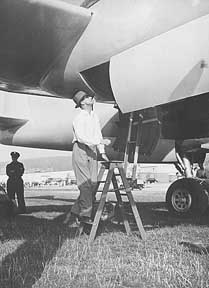 Department and pitched his plane as a bomber. Unfortunately, they didn’t like his use of a resin bonded plywood construction and rejected his ideas. Department and pitched his plane as a bomber. Unfortunately, they didn’t like his use of a resin bonded plywood construction and rejected his ideas. Hughes went ahead and secretly developed the plane he called the D-2 in a hangar built on Harpers Dry Lake, near Muroc Dry Lake (near present-day Edwards Air Force Base). In spite of the tight security, Army officials were permitted to see the aircraft and were impressed. However, before the Army could consider the craft for production, the one-and-only Hughes D-2 was destroyed when lightning struck the D-2 hangar. But the Army had seen enough. They asked Hughes for a high-altitude photographic reconnaissance version built from aluminum. Hughes took much of his D-2 design, its twin-boom, twin-engines and relatively small central crew nacelle and began work on a new aircraft, the XF-11.
| 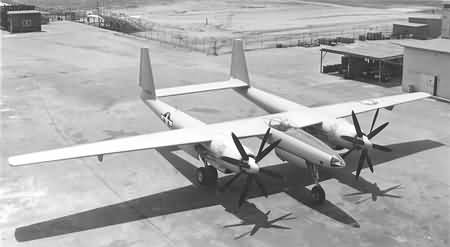
| The Hughes XF-11 was to powered by two powerful Pratt & Whitney Model R-4360-31 radial air-cooled, 28 cylinder engines, and was destined to be one of the fastest aircraft of its day. In modern terms, it was like an propeller-driven SR-71. Among it's notable features were the pressurized cockpit and counter-rotating propeller blades, (as well as a wingspan of over a hundred feet!). It was also designed to meet or exceed the same exacting specifications as the Republic XR-12 "Rainbow" in flight. Originally, the Army contracted for 100 of the airplanes to be built, but after the end of World War 2, the contract was cancelled, and Hughes was left with two, very expensive, prototypes. | | An Early Run... During a taxi test of the XF-11, Hughes complained that he was not getting full power on the XF-11 and wanted Frank J. Prinz, a service engineer for Hughes, to ride with him and find the reason why. "The XF-11 is a single place, but I managed to squeeze in behind him." according to Prinz. "So, he applied full power and actually lifted off the field. The field was turf and two miles long. Both of our eyes were on the instruments and when we looked up the eucalyptus trees at the end of the field were fast coming up. Hughes slammed on the brakes to no avail, burned them out and blew the tires. I reached over his left shoulder, flipped up the safety on the reverse switch and threw them into reverse. The props worked." The propellers went into reverse and the aircraft stopped less than 50 feet from the trees. Hughes looked back at Prinz and did not say a word. "We then limped back to where we started from. Hughes got out and went into a car without saying a word to anyone. I believe he was really shook up. Had the props not worked and not gone into reverse, we would both have been history." Prinz said.
It was later determined that the reason Hughes was not getting full power was that the blade angle on the low end was not set properly. When that was taken care of, full power was obtained.
| Making the Best... On July 7th, 1946, the XF-11 (Tail no. 44-70155) was readied for her maiden flight, with Howard Hughes himself behind the controls. Although it was planned to be only a short 20 minute flight, Hughes amended the plan after take-off to include an aerial tour of the Los Angeles basin to show off his latest aircraft. After a series of test maneuvers, Hughes begun his return to his factory's airport in Culver City when the right engine propeller control's ran out of oil due to an undetected leak. The rear portion of the propeller kicked into a "flat pitch" like indoor ceiling fans and forced one of the sets of blades to cease working, according to Frank Prinz, who was the service engineer on the propellers. This also caused the aircraft to yaw terribly from the drag the limp propeller created. He radioed his difficulties backed to the airport, and stated he was going to land. | 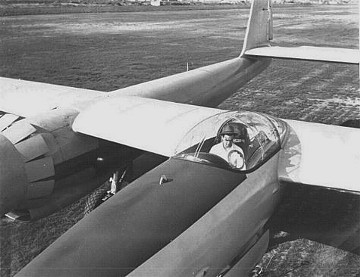
| 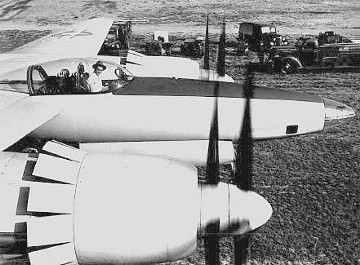
| Having decided to save his eight-million dollar aircraft, and not risk endangering those on the ground by bailing out, Hughes attempted to make an emergency landing at the Los Angeles Country Club. But his luck had run out, he dove downward short of the golf course, and into a neighborhood in Beverly Hills. | 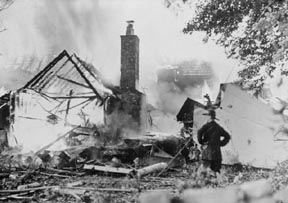
Impact! At 7:20 in the evening, Hughes struck three homes in Beverly Hills, destroying one in a burst of flames. Actor Dennis O'Keefe, living at 802 North Linden Drive (and best known from his role acting with John Wayne in movie The Fighting Seabees), called the fire department, and crowds came from miles to see the spectacle. | 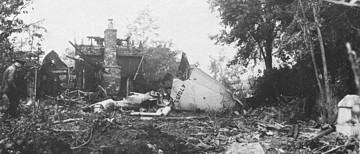 | 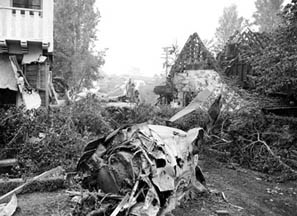 | The wreckage (note the tail section) strewn throughout the backyard at 808 Whittier | One of the engines, thrown between the homes at 808 & 810 Whittier |
| 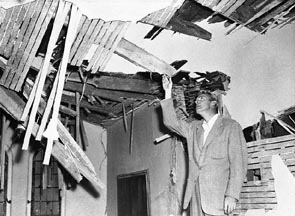 Actor Dennis O'Keefe inspects the damage to the house of Dr. Jules Zimmerman, whose roof was sliced by the XF-11's wingtips and landing gear. Actor Dennis O'Keefe inspects the damage to the house of Dr. Jules Zimmerman, whose roof was sliced by the XF-11's wingtips and landing gear.
| The resulting crash crushed Hughes' collar bone, broke six of his ribs, damaged his lungs severely, and suffered third-degree burns on his hands. Hughes was rushed to a nearby hospital, then transferred to Good Samaritan Hospital in Los Angeles, where he required the use of an 'oxygen tent' for several days, while being visited by a "Who's Who" of Hollywood fame and fortune of the time. Even the newspapers printed the daily progress of Hughes' recovery, during which time he directed that the remaining XF-11 prototype be refitted with a single pair of propellers. Hughes also noted the problems with the hospital bed he resided in. He suggested and designed with changes to the bed, some of which now are standard in modern hospital beds everywhere. | However, liberal dosages of morphine were prescribed to Hughes for the pain he suffered, to which is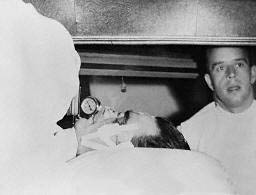 often credited as the source of his lifelong addiction to codeine and other opiates. Also, Hughes' later-trademark moustache grew as a result to cover up a scar that he acquired from this accident. often credited as the source of his lifelong addiction to codeine and other opiates. Also, Hughes' later-trademark moustache grew as a result to cover up a scar that he acquired from this accident. Laying Blame... Although an investigation of the accident determined that the primary cause was a propeller malfunction, it was cited that if Hughes had followed his original flight plan, the XF-11 would have been safely back on the ground and the oil leak discovered and repaired, thus preventing the crash. It was also noted that Hughes had not followed standard procedures, such as not using the assigned radio frequency and retracting the landing gear, which is not normally done on a maiden flight. Frank Prinz also served on the accident investigation board. According to him, "Had Hughes had the presence of mind, he would have shut off the engine and brought back the aircraft safely."
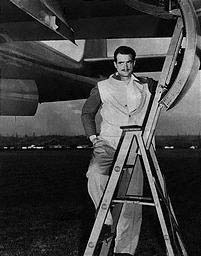 Ultimately, Hughes made the first flight of the second XF-11 prototype on April 5, 1947. This time the test flight went off without a hitch. The XR-11 was a remarkably stable aircraft, and at high speeds lateral control was excellent – but it became somewhat unstable at low speeds. Ultimately, Hughes made the first flight of the second XF-11 prototype on April 5, 1947. This time the test flight went off without a hitch. The XR-11 was a remarkably stable aircraft, and at high speeds lateral control was excellent – but it became somewhat unstable at low speeds.
The XF-11 never became the Air Force's high-altitude photographic reconnaissance aircraft. The program was canceled in favor of utilizing the much more economical Boeing RB-50s to meet the long-range photo-reconnaissance requirement. However, the remarkably clean, low drag profile of the XF-11, with its long, straight wing perhaps inspired a similar design a decade later in the Lockheed U-2. | |
| The Crash Site TodayOff to wreck chase in Beverly... Hills, that is...
The land of movie stars, swimming pools, and crashed airplanes! | As his impaired craft neared the club and perhaps a safe landing, Hughes realized by the way his plane was dropping he wasn't going to make it, but it was too late to do anything else but brace for impact. Just seconds short of the club (about 300 feet), the XF-11 struck the first of three separate homes along it's flight line. First, it scraped through the roof of the home of Doctor Jules Zimmerman, a noted dentist, at 803 North Linden Drive, momentarily bouncing the plane back into the air. | 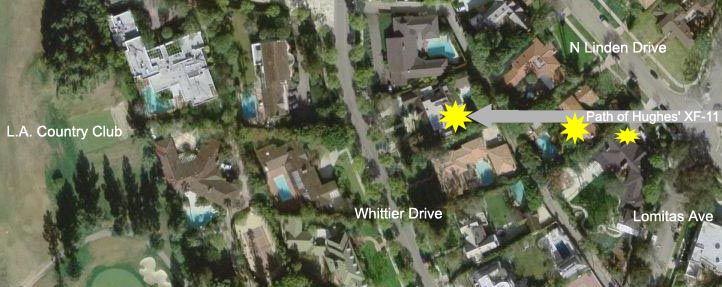
| Next, it hit the house next door at 805 North Linden Drive of actress Rosemary DeCamp (best known for her role as James Cagney's mother in Yankee Doodle Dandy). It sliced through the bedroom where her and her husband, John Staler, were, and ripped across the couple's garage rooftop. Fortunately they both escaped injury. The final stop for Hughes and his XF-11 was the backside of 808 Whittier Drive, the home of Lt. Colonel Charles A. Myers, the chief interpreter for the United States during the trials at Nuremberg. The plane's fuel tanks exploded, turning the house into an raging inferno & leveling the structure, resulting in over $100,000 in property damage. | 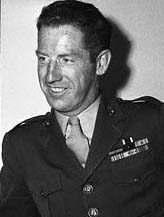
| Marine Master Technical Sergeant Durkin |
| The XF-11 was shattered into pieces with flaming debris scattered everywhere from backyards to the streets, yet somehow Hughes, bloodied, broken, and burned, was still alive! Still conscious, Hughes managed to get out of the plane and laid next to it as it was still burning. A Marine visiting friends across the street from the Myers residence, Master Technical Sergeant William L. Durkin, an enlisted member of the United States Marine Corps, risked his own life by pulling Hughes away from the burning wreckage, saving Hughes' life. Later, Sergeant Durkin was offered repeated thanks, in monetary form, by Hughes, but he declined all compensation and publicity from his act of heroism, citing that anybody should have, and would have, done the same thing in that same situation. |
| The details of the first flight and crash of the XF-11 were detailed in the Howard Hughes biopic, The Aviator . . The film was nominated for several Academy Awards, including a nod for Best Picture. The movie went on to win 5 'Oscars', including Art Direction, Costume Design, Best Film Editing, and Cinematography. To see footage of many of the intense effects scenes from the film, follow this link to www.AviatorFX.com The crash was also depicted in the 1977 made-for-TV movie, The Amazing Howard Hughes, starring Tommy Lee Jones as Hughes. In the movie, a P-38 stood in for the XF-11. | | |
|
Click here to visit Check-Six.com, Offering Aviation History and Adventure First-Hand              
                   
|
